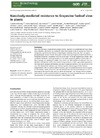Please use this identifier to cite or link to this item:
https://accedacris.ulpgc.es/jspui/handle/10553/41845
| Title: | Nanobody-mediated resistance to Grapevine fanleaf virus in plants | Authors: | Hemmer, Caroline Djennane, Samia Ackerer, Léa Hleibieh, Kamal Marmonier, Aurélie Gersch, Sophie Garcia, Shahinez Vigne, Emmanuelle Komar, Véronique Perrin, Mireille Gertz, Claude Belval, Lorène Berthold, François Monsion, Baptiste Schmitt-Keichinger, Corinne Lemaire, Olivier Lorber, Bernard Gutiérrez, Carlos Muyldermans, Serge Demangeat, Gérard Ritzenthaler, Christophe |
UNESCO Clasification: | 3109 Ciencias veterinarias 3108 Fitopatología |
Keywords: | Nanobodies Plant virus Transgenic plant Grapevine Nepovirus, et al |
Issue Date: | 2018 | Journal: | Plant Biotechnology Journal | Abstract: | Since their discovery, single-domain antigen-binding fragments of camelid-derived heavy-chain-only antibodies, also known as nanobodies (Nbs), have proven to be of outstanding interest as therapeutics against human diseases and pathogens including viruses, but their use against phytopathogens remains limited. Many plant viruses including Grapevine fanleaf virus (GFLV), a nematode-transmitted icosahedral virus and causal agent of fanleaf degenerative disease, have worldwide distribution and huge burden on crop yields representing billions of US dollars of losses annually, yet solutions to combat these viruses are often limited or inefficient. Here, we identified a Nb specific to GFLV that confers strong resistance to GFLV upon stable expression in the model plant Nicotiana benthamiana and also in grapevine rootstock, the natural host of the virus. We showed that resistance was effective against a broad range of GFLV isolates independently of the inoculation method including upon nematode transmission but not against its close relative, Arabis mosaic virus. We also demonstrated that virus neutralization occurs at an early step of the virus life cycle, prior to cell-to-cell movement. Our findings will not only be instrumental to confer resistance to GFLV in grapevine, but more generally they pave the way for the generation of novel antiviral strategies in plants based on Nbs. | URI: | https://accedacris.ulpgc.es/handle/10553/41845 | ISSN: | 1467-7644 | DOI: | 10.1111/pbi.12819 | Source: | Plant Biotechnology Journal [ISSN 1467-7644], v. 16 (2), p. 660-671 |
| Appears in Collections: | Artículos |
SCOPUSTM
Citations
54
checked on Jun 8, 2025
WEB OF SCIENCETM
Citations
45
checked on Jun 8, 2025
Page view(s)
60
checked on Sep 16, 2023
Download(s)
82
checked on Sep 16, 2023
Google ScholarTM
Check
Altmetric
Share
Export metadata
Items in accedaCRIS are protected by copyright, with all rights reserved, unless otherwise indicated.
